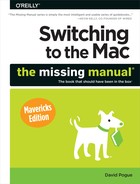You get new mail and send mail you’ve already written using the Get Mail command. You can trigger it in any of several ways:
Choose Mailbox→Get All New Mail (or press Shift-⌘-N).
Right-click (or two-finger click) Mail’s Dock icon, and choose Get New Mail from the shortcut menu. (You can use this method from within any program, as long as Mail is already open.)
Wait. Mail comes set to check your email automatically every few minutes. To adjust its timing or to turn this feature off, choose Mail→Preferences, click General, and then choose a time interval from the “Check for new messages” pop-up menu.
Tip
If you choose Automatically, a new feature in Mavericks, then you’ll get incoming messages the instant they arrive—at least in any accounts that offer “push” email.
Now Mail contacts the mail servers listed in the Accounts pane of Mail’s preferences, retrieving new messages and downloading any files attached to those messages. It also sends any outgoing messages that couldn’t be sent when you wrote them.
Tip
The far-left column of the Mail window has a tiny Mail Activity monitor tucked away; click the second button (![]() ) at the lower-left corner of the Mail window to reveal Mail Activity. If you don’t want to give up mailboxes-list real estate, or if you prefer to monitor your mail in a separate window, you can do that, too. The Activity window gives you a Stop button, progress bars, and other useful information. Summon it by choosing Window→Activity, or by pressing ⌘-0.
) at the lower-left corner of the Mail window to reveal Mail Activity. If you don’t want to give up mailboxes-list real estate, or if you prefer to monitor your mail in a separate window, you can do that, too. The Activity window gives you a Stop button, progress bars, and other useful information. Summon it by choosing Window→Activity, or by pressing ⌘-0.
Also, if you’re having trouble connecting to some (or all) of your email accounts, choose Window→Connection Doctor. There you can see detailed information about accounts that aren’t responding. If your computer’s Internet connection is at fault, you can click Network Diagnostics to try to get back online.
The mailboxes panel, the leftmost list on the screen, lists all your email accounts’ folders (and subfolders, and sub-subfolders) for easy access.
Tip
You can also collapse or expand the various sections of the mailboxes list (On My Mac and Reminders, for example) by clicking the Hide or Show button next to each one. That button doesn’t appear, however, until you point to the capitalized section title (like MAILBOXES or ON MY MAC).
Under the Mailboxes heading, you may find these folders:
Inbox holds mail you’ve received. If you have more than one email account, you can expand the triangles to see separate folders for each of your accounts. You’ll see this pattern repeated with the Sent, Junk, and other mailboxes, too—separate accounts have separate subheadings.
Tip
If Mail has something to tell you about your inbox (like, for instance, that Mail can’t connect to it), a tiny warning triangle (
 ) appears on the right side of the Mailboxes heading. Click it to see what Mail is griping about.
) appears on the right side of the Mailboxes heading. Click it to see what Mail is griping about.If you see a wavy
 icon, that’s Mail’s way of announcing that you’re offline. Click the icon to try to connect to the Internet.
icon, that’s Mail’s way of announcing that you’re offline. Click the icon to try to connect to the Internet.VIPs displays messages from the most important people in your life—those you’ve designated as VIPs (VIPs). This folder doesn’t appear if you haven’t identified any VIPs.
Flagged. If you’ve flagged any messages, the flag headings appear here, too. (Flags are described later in this chapter.)
Outbox holds mail you’ve written but haven’t yet sent (because you were on an airplane when you wrote it, for example). If you have no mail waiting to be sent, then the outbox disappears.
Drafts holds messages you’ve started but don’t want to send just yet.
Sent, unsurprisingly, holds copies of messages you’ve sent.
Trash works a lot like the Trash on your desktop, in that messages you put there don’t actually disappear. They remain in the Trash folder until you permanently delete them—or until Mail’s automatic trash-cleaning service deletes them for you.
Junk appears when you use Mail’s spam filter, as described later in this chapter.
Mail Activity. You don’t need to summon a separate window to see how much more of that message with the giant attachment the program still has to send. To reveal the Mail activity panel, click the tiny
 icon below the Mailboxes list.
icon below the Mailboxes list.
